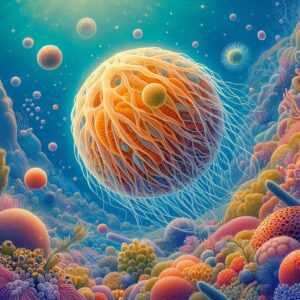
Scientists propose that LUCA—the Last Universal Common Ancestor of all life on Earth—emerged ~4.2 billion years ago, a mere 300 million years after Earth’s formation. This groundbreaking timeline, based on genetic and molecular studies, reshapes our understanding of life’s rapid appearance on a young, hostile planet.
KEY FACTS ABOUT LUCA
- Definition: LUCA is the most recent organism from which all extant life (Bacteria, Archaea, and Eukarya) diverged.
- No Fossil Evidence: Inferred through comparative genomics—genes shared across all three domains likely originated in LUCA.
- Timeline: Existed during the Hadean/early Archean eon, surviving extreme conditions like asteroid bombardment and volcanic activity.
LUCA’S CHARACTERISTICS
- Anaerobic Lifestyle:
- Thrived in an oxygen-free environment, consistent with Earth’s early anoxic atmosphere.
- Thermophilic Nature:
- Likely inhabited hydrothermal vent systems, where geothermal heat and mineral-rich fluids provided energy and nutrients.
- Metabolism:
- Utilized hydrogen (H₂), carbon dioxide (CO₂), and nitrogen (N₂) from its surroundings.
- Produced ammonia (NH₃) and organic compounds via simple biochemical pathways, possibly the Wood-Ljungdahl pathway (a primitive carbon-fixation process).
- Genetic Simplicity:
- Estimated to have had ~500 genes, encoding basic cellular functions (e.g., replication, metabolism).
EVIDENCE FOR LUCA
- Universal Genes: Over 300 genes are shared by all life forms, including those for ATP synthesis, ribosomes, and DNA replication.
- Molecular Clocks: Genetic mutation rates suggest LUCA existed ~4.2 billion years ago, aligning with geochemical models of early Earth.
- Extremophile Relatives: Modern thermophilic Archaea (e.g., Methanogens) and deep-sea vent bacteria mirror LUCA’s inferred traits.
SIGNIFICANCE OF THE DISCOVERY
- Origin of Life Insights:
- Supports the hypothesis that life arose rapidly in hydrothermal vent ecosystems, leveraging geochemical energy.
- Astrobiology Implications:
- Suggests life could emerge quickly on other planets with similar conditions (e.g., subsurface oceans on icy moons).
- Evolutionary Biology:
- LUCA’s metabolic flexibility explains how life diversified into Bacteria, Archaea, and later Eukarya (via endosymbiosis).
OPEN QUESTIONS & DEBATES
- Pre-LUCA Life: Was LUCA the “first life,” or part of a broader community of early organisms?
- Horizontal Gene Transfer (HGT): How did gene sharing between ancient microbes obscure LUCA’s genetic footprint?
- Eukaryotic Origins: Eukarya’s complexity likely arose 2 billion years after LUCA—what triggered this leap?
MODERN ANALOGUES
- Hydrothermal Vent Ecosystems: Modern vent microbes (e.g., Aquifex) use H₂ and CO₂, mirroring LUCA’s metabolism.
- Nitrogen-Fixing Bacteria: LUCA’s ammonia production parallels modern nitrogen cycles, critical for life’s nutrient supply.
FUTURE RESEARCH
- Synthetic Biology: Reconstructing LUCA’s genome in labs to test its hypothesized functions.
- Deep-Time Geochemistry: Analyzing ancient rocks to trace metabolic signatures of early life.
- Space Missions: Exploring icy moons (e.g., Europa) for LUCA-like ecosystems.
